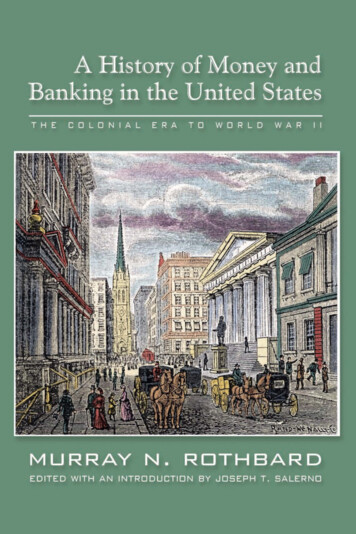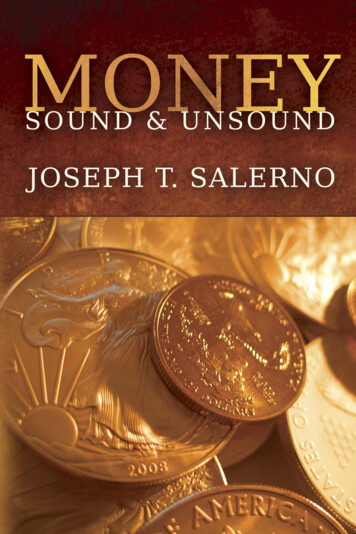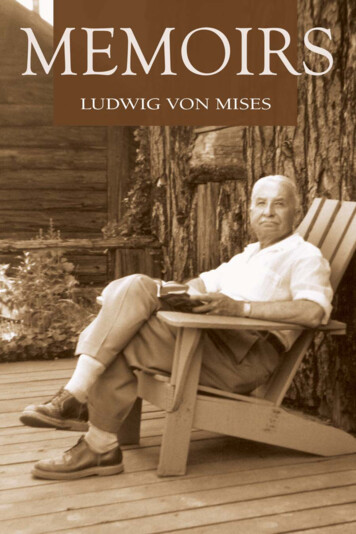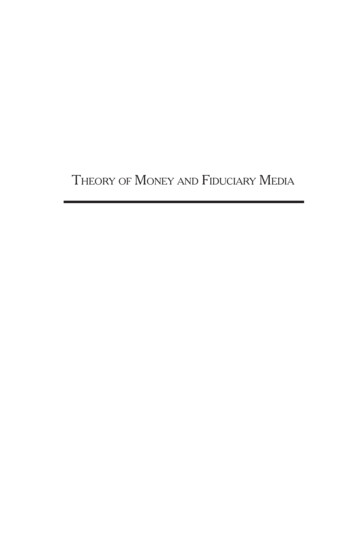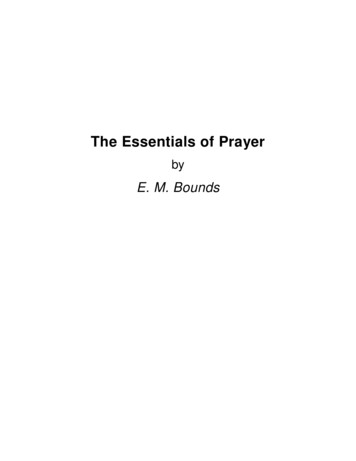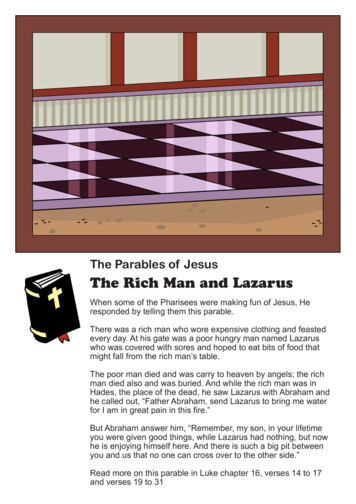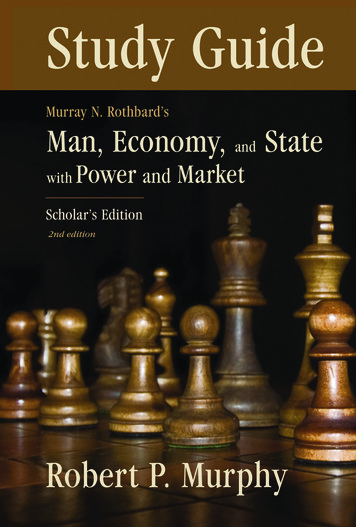
Transcription
STUDY GUIDETOMAN, ECONOMY, AND STATEA TREATISE ON ECONOMIC PRINCIPLESWITHPOWER AND MARKETGOVERNMENT AND THE ECONOMY
The Mises Institute dedicates this volumein deepest gratitude toMr. Paul C. Reinhard.
STUDY GUIDETOMAN, ECONOMY, AND STATEA TREATISE ON ECONOMIC PRINCIPLESWITHPOWER AND MARKETGOVERNMENT AND THE ECONOMYSCHOLAR’S EDITIONMURRAY N. ROTHBARDROBERT P. MURPHYLudwigvon MisesInstituteAUBURN, ALABAMA
Copyright 2006 by Ludwig von Mises InstituteAll rights reserved. Written permission must be secured from the publisher touse or reproduce any part of this book, except for brief quotations in criticalreviews or articles.Published by the Ludwig von Mises Institute518 West Magnolia Avenue, Auburn, Alabama 36832-4528.ISBN-13: 978-1-933550-00-8ISBN-10: 1-933550-00-7
CONTENTSINTRODUCTION . . . . . . . . . . . . . . . . . . . . . . . . . . . . . . . . . . . . . . .viiMAN, ECONOMY, AND STATECHAPTER 1— FUNDAMENTALS OF HUMAN ACTION . . . . . . . . .1CHAPTER 2— DIRECT EXCHANGE . . . . . . . . . . . . . . . . . . . . .15CHAPTER 3— THE PATTERN OF INDIRECT EXCHANGE . . . . .27CHAPTER 4— PRICES AND CONSUMPTION . . . . . . . . . . . . . . .39CHAPTER 5— PRODUCTION: THE STRUCTURE . . . . . . . . . . .55CHAPTER 6— PRODUCTION: THE RATE OF INTERESTAND ITS DETERMINATION . . . . . . . . . . . . . . . . .69CHAPTER 7— PRODUCTION: GENERAL PRICINGOF THE FACTORS . . . . . . . . . . . . . . . . . . . . . . . .81CHAPTER 8— PRODUCTION: ENTREPRENEURSHIPAND CHANGE . . . . . . . . . . . . . . . . . . . . . . . . . . .93v
viStudy Guide to Man, Economy, and State with Power and MarketCHAPTER 9— PRODUCTION: PARTICULAR FACTORPRICES AND PRODUCTIVE INCOMES . . . . . . . .107CHAPTER 10— MONOPOLY AND COMPETITION . . . . . . . . . . .121CHAPTER 11— MONEY AND ITS PURCHASING POWER . . . . . .135CHAPTER 12— THE ECONOMICS OF VIOLENTINTERVENTION IN THE MARKET . . . . . . . . . .155POWER AND MARKETCHAPTER 1— DEFENSE SERVICES ON THE FREE MARKET . .175CHAPTER 2— FUNDAMENTALS OF INTERVENTION . . . . . . . .181CHAPTER 3— TRIANGULAR INTERVENTION . . . . . . . . . . . . .189CHAPTER 4— BINARY INTERVENTION: TAXATION . . . . . . . .203CHAPTER 5— BINARY INTERVENTION: GOVERNMENTEXPENDITURES . . . . . . . . . . . . . . . . . . . . . . . .219CHAPTER 6— ANTIMARKET ETHICS: A PRAXEOLOGICALCRITIQUE . . . . . . . . . . . . . . . . . . . . . . . . . . . . .229CHAPTER 7— CONCLUSION: ECONOMICSAND PUBLIC POLICY . . . . . . . . . . . . . . . . . . . .241INDEX . . . . . . . . . . . . . . . . . . . . . . . . . . . . . . . . . . . . . . . . . . . .249
INTRODUCTIONIn June of 2004, I became convinced of the need for a studyguide to accompany what is arguably the single most importantbook for the student of Austrian economics and libertarian policy analysis. Murray Rothbard’s Man, Economy, and State is simply the most comprehensive exposition of Austrian economicsthat exists. Although Mises’s Human Action is itself a self-contained, beautiful work of sheer brilliance, it is nonetheless thecase that, in his subsequent work, Rothbard teaches economicsmore clearly. Power and Market builds on the analysis of Man,Economy, and State to provide an exhaustive classification andcritique of government intervention in all of its various forms.Originally intended as a single volume, Man, Economy, and Stateand Power and Market were published separately due to (alleged)space constraints and, no doubt, the radical positions containedin the latter. The Mises Institute’s lovely Scholar’s Edition hasreunited these two works as Rothbard meant them to be. However, I shall omit further discussion of the publication background (inasmuch as a historical sketch is provided in JosephStromberg’s Introduction to the scholar’s edition) and explainthe format of this study guide.The chapters of this guide match the twelve of Man, Economy, and State and the seven of Power and Market; appendicesvii
viiiStudy Guide to Man, Economy, and State with Power and Marketare handled within each chapter. A typical chapter1 begins witha one-page summary. This is then followed by a detailed outlineof the chapter, which follows Rothbard’s format (Arabic numerals, then English letters, etc.) for sections and subsections. (Thelength of Rothbard’s chapter consequently influences the lengthof the detailed outline in the study guide.) Following thedetailed outline are the “contributions” of the chapter. Sometimes these observations refer to techniques or doctrines thatare unique to the Austrian School, while at other times theyrefer to innovations engineered by Rothbard himself. (This distinction is always made clear.) The next section contains thetechnical details, intended for advanced readers (in particulargraduate students). Generally, in this section I contrasted Rothbard’s approach with mainstream economics, but I also (especially for chapters from Power and Market) would sometimesconsider objections that Rothbard had not, or would simplytake a given discussion a little further than he had done in thetext.Finally, each chapter of the study guide contains ten questions. Some of the questions merely test reading comprehension; they ensure that the conscientious (but perhaps intimidated and/or overwhelmed) reader is absorbing the importantpoints. However, especially to challenge the more advancedreaders, some of the questions take an advocatus diaboli approachand point to ostensible contradictions or problems with Rothbard’s analysis. (Whether the reader can resolve the allegedflaws or not, he or she will undoubtedly understand Rothbard’scase much more after considering these questions.) Where1Isay “typical” because some chapters in Power and Market are soshort that their corresponding treatments in this study guide containmerely the summary or the detailed outline.
Introductionixappropriate, I have included the relevant page numbers (fromthe scholar’s edition) after each question to save the reader time.I strongly urge all those who take Austrian economics seriously to read (at least large portions of) Rothbard’s treatise; Iwould go so far as to say that a modern academic cannot reallycall him or herself an Austrian economist without doing so. Forthose who may be intimidated or discouraged by the massivevolume, I hope that this study guide will at least “chart the territory” and allow them to begin in those topics that most interest them. At that point, I suspect, Rothbard’s spell will overtakethem and they will be compelled to read all 1,441 pages.Let me end this brief introduction by urging even olderexperts to reread this important book. I myself had read Man,Economy, and State cover to cover in college, and yet I wasamazed at how much better it had grown over the years! In addition, I hope that this study guide may provide a useful referencefor such experts. (I myself have used it to refresh my memory ona particularly subtle aspect of Rothbard’s approach to capitaland growth.)Enough now with the introduction. . . . The reader mustopen the treatise and let the learning begin!ROBERT P. MURPHYJanuary 2006
CHAPTER 1FUNDAMENTALS OF HUMAN ACTIONChapter SummaryPraxeology is the scientific study of human action, which ispurposeful behavior. A human acts whenever he uses means toachieve an end that he or she subjectively values. Human actionis thus teleological or intentional; a person acts for a reason.Therefore not all human behavior is action in the praxeologicalsense: purely reflexive or unconscious bodily movements (suchas coughing when exposed to tear gas) are not examples ofaction. Praxeology starts from the undeniable axiom thathuman beings exist and act, and then logically deduces implications of this fact. These deduced propositions are true a priori;there is no need to test them in the way that a physicist mighttest a proposed “law” of Nature. So long as a praxeologicalstatement has been derived correctly, it must necessarily containas much truth as the original axioms.All action involves an exchange, or a choice: the actor attemptsto achieve a more satisfactory state of affairs than what wouldhave occurred had the actor chosen differently. The benefit ofan action is its psychic revenue, while its cost is the value the actorplaces on the next-best alternative. Each actor can arrange various possible ends on a scale of value. This is a purely ordinalranking, that can only show which end is first-best, secondbest, and so forth. There is no sense in saying that one end is 81
2Study Guide to Man, Economy, and State with Power and Marketpercent better than another, because there is no cardinal unit ofhappiness.Every action involves not only a value judgment concerningdifferent ends, but also a belief on the part of the actor that hepossesses adequate means to achieve his desired end. (A personmay prefer sunshine to rain, but this preference alone will notlead to any action if the person does not believe he has thepower to change the weather.)Only individuals can act, because only individuals have valuations and can make choices. It is thus metaphorical to say that“the people elected the president” or “Germany attackedFrance.” Of course, individuals may act in a particular waybecause of political ideas or because military generals gave certain orders; nonetheless it is always individuals who act.All action takes place in time. We can define the time beforea given action, the duration of the action, and the time after agiven action. All action is future-oriented, in the sense thataction seeks to create a more desirable future from the actor’sviewpoint. All individuals possess time preference, which meansthat they prefer a given satisfaction sooner rather than later.Individuals make decisions on the margin. No one everchooses between “diamonds” and “water.” Rather, an individualmust choose between a definite amount of diamonds and a definite amount of water.All action involves uncertainty of the future. (If the futurewere completely known and hence determined, there would beno scope for action.) Entrepreneurship involves coping with thisuncertainty by forecasting future conditions, and hence isimplicit in every action.
Chapter 1: Fundamentals of Human Action3Chapter Outline1. The Concept of ActionThe distinctive feature of the study of man is action, which ispurposeful behavior. (A falling rock is not “acting” because itdoesn’t “wish” to get closer to the ground.) But the social scientist (including the economist) must impute subjective intentions to the objects of his study (i.e., acting human beings).Action must exist; if beings did not behave purposefully, theywould not be human.Praxeology is the scientific study of action. It begins with theobvious truth that action exists, because human beings exist. (Ifthings did not behave purposefully, so that the observer couldascribe motives to the things, then they would not be classifiedas human.) Praxeology consists of all the propositions that canbe logically derived from the action axiom. Economics is thebest developed subdivision of praxeology. (NOTE: Some economic propositions require supplementary assumptions besidesthe action axiom.)2. First Implications of the ConceptOnly individuals can act. When people say things such as,“The group went to the park,” or “Germany attacked France,”this is really just a shorthand for saying that certain individualsperformed these actions. This is purely a methodological point;it does not (as many critics falsely assert) mean that economistsdeny the existence of social collectives, or that economists thinkindividuals always behave “atomistically.” Of course, a personmay act differently when he is in a mob. But nonetheless even“mob behavior” is still the sum total of the behavior of eachindividual comprising the “mob.” A chemist can say that all
4Study Guide to Man, Economy, and State with Power and Marketmatter is composed of atoms without thereby denying the existence of molecules.A person will act only if he desires a particular state of affairsand only if he believes he has the capacity to bring this about.For example, a man may desire sunshine on a cloudy day, butthis desire alone will not lead to any action, because the man hasno idea how to change the weather.A man uses means to (attempt to) achieve his ends. When aman uses a certain means for one end, then he cannot use it forsome other possible end; we thus say that the means is scarce. Incontrast, if a particular item or condition is so abundant thatman is not faced with a choice in its disposal, then it is not ameans but a general condition of the environment. (For example,air is certainly necessary for action, but we would not normallyclassify it as a means to an end.)All action takes place in time. For any given action, we canconceive of the time before the action, the time absorbed by theaction, and the time following the action. Time is scarce. Thefuture itself is uncertain, and hence acting man must engage inentrepreneurship by speculating about future conditions and theresults of various possible actions.Acting man must rank the possible ends in order of desirability. Because means are scarce, acting man must allocatethem to fulfill his most highly ranked ends; i.e., acting manmust economize the means. Even though a man will always dispose of his means in an attempt to achieve his most highlyranked ends, because of uncertainty the man may err.3. Further Implications: The MeansThe means to satisfy wants are called goods. Those goodsthat directly satisfy wants are consumers’ goods or goods of the firstorder. Those goods that are useful only indirectly in satisfyingwants are producers’ goods or factors of production or goods of higher
Chapter 1: Fundamentals of Human Action5order. (These terms are interchangeable, depending on the context.) If a ham sandwich is the consumers’ good, then the loaf ofbread, labor of the housewife (in making the sandwich), and theunsliced ham would all be first-order producers’ goods. Goodswhich are involved in the production of these goods (perhaps thelabor of the store clerk in selling the loaf of bread) would be second-order producers’ goods, and so forth.The two original factors of production are labor and land.(Land is a technical term that includes not only land in the popular sense, but all natural resources, such as deposits of copper.)In addition to these factors we also have capital goods, which arefactors of production that are themselves produced by humanbeings (with labor, land, and possibly other capital goods).Notice that all capital goods can ultimately be traced back to theinput of the original factors, land and labor.The value of producers’ goods derives from the value thatacting man places on the final, consumers’ goods that they produce. In our example above, the loaf of bread is valuable becauseit contributes to the production of the ham sandwich.4. Further Implications: TimeThe time elapsing from the beginning of an action until theend is achieved is the period of production. The period of production is the working time plus the maturing time. Note that theperiod of production for a given consumer good does notinclude the time used in the construction of all capital goodsused in the process. Although the economist must distinguishbetween original and produced factors, acting man does notcare about the past; he takes the supplies of labor, land, andpresently available (i.e., previously produced) capital goods as agiven when he forms his plans.
6Study Guide to Man, Economy, and State with Power and MarketAll people prefer a given end to be achieved sooner ratherthan later. This is the universal fact of time preference. Apparentcounterexamples to this law are due to confusion over thenature of a good. For example, if a person in the winter prefers“future ice” to “present ice,” this does not violate the law oftime preference, because ice-in-the-summer is a different goodfrom ice-in-the-winter.5. Further ImplicationsA. Ends and ValuesAll action aims at exchanging a less satisfactory stateof affairs for a more satisfactory state. We can say thatindividuals rank outcomes in terms of happiness, utility,satisfaction, contentment, etc. Regardless of the name,these terms are purely formal, and do not imply hedonism or crude Benthamite utilitarianism.Value rankings are always ordinal, never cardinal.There is no unit of happiness or utility, and hence we canonly say that a man preferred A to B; we can never say hepreferred A “three times as much.”B. The Law of Marginal UtilityEach unit of a good is valued separately. People neverchoose between “guns” or “butter” but rather between aunit of guns and a unit of butter. The total supply or stockof a good is defined by units that are equally serviceable,or interchangeable, from the actor’s point of view.As an actor acquires more and more units of a good,he devotes them to successively less and less urgent ends(i.e., ends that are lower on his scale of values). Thereforethe marginal utility of a good declines as its supplyincreases. This is the law of diminishing marginal utility.
Chapter 1: Fundamentals of Human Action76. Factors of Production: The Law of ReturnsUnits of producers’ goods are also evaluated on the margin.The value assigned to a unit of a producers’ good is the value ofthe consumers’ goods that would be lost if the marginal unit ofthe producers’ good in question were no longer available. (Thisis the marginal product of the factor of production.)The factors of production necessary to produce a certainconsumer good are called complementary factors of production. Thelaw of returns states that with the quantity of complementaryfactors held constant, there always exists some optimumamount of the varying factor.7. Factors of Production: Convertibility andValuationFactors of production differ in their degree of specificity, i.e.,the variety of consumers’ goods that they can produce. Labor iscompletely nonspecific, because it is used in the production ofevery consumers’ good. The less specific a factor is, the moreconvertible it is when conditions change and plans must bealtered.8. Factors of Production: Labor versus LeisureThroughout the book we assume that human beings findlabor onerous; i.e., we assume that individuals value leisure as aconsumer good.9. The Formation of CapitalCapital goods can be produced only through the act of saving, i.e., consuming less in the present than one’s means allow.We can imagine Robinson Crusoe on his desert island, able topick berries with his bare hands. If Crusoe invests some of his
8Study Guide to Man, Economy, and State with Power and Marketlabor, not on immediate consumption (i.e., picking berries), butrather on the creation of capital goods such as a stick, then hecan increase his future consumption of berries. This would be a“roundabout” method of picking berries; in general thesemethods are more physically productive than shorter, moredirect methods. An actor will opt for longer, more roundaboutmethods so long as the enhanced output more than offsets theincreased waiting time, which in itself is a disadvantage becauseof time preference.
Chapter 1: Fundamentals of Human ActionNotable Contributions The Misesian scheme of praxeology is a unique featureof the Austrian School. Whereas other schools of thought(to the extent that they even concern themselves withmethodology at all) embrace some form of positivism orinstitutionalism, the Austrians are unique in stressing thea priori, deductive nature of economic law. The structure of production concept is also a particularlyAustrian feature. By classifying goods as first-, second-,third-order, and so on, the Austrians never lose sight ofthe fact that production takes time. The ordering of goodsin this fashion goes back to Menger, but it was BöhmBawerk who fully elaborated the role of savings and capital accumulation. Mainstream economists, such as J.B.Clark and Frank Knight, downplayed the role of production time in modern economies. They would argue that ifa production process is fully “synchronized,” such thatinputs in the highest stages correspond to output emerging from the other end, then there is no apparent time lagbetween investment and consumption. (Of course, this isonly true in a stationary state.) The use of “Robinson Crusoe” scenarios, althoughpopular in earlier economic treatises, has come under firefor being “unrealistic.” The Austrians continue to stressthe importance of the study of isolated man to discover apriori truths that are useful in the study of man in society. There is a subtle difference between the philosophical position of Rothbard and Mises. In Human Action,9
10Study Guide to Man, Economy, and State with Power and MarketMises says that man acts to remove “felt uneasiness.”Rothbard, in contrast, merely says that man acts toachieve a more satisfactory state of affairs (i.e., Rothbard’s position is not as “pessimistic”).
Chapter 1: Fundamentals of Human ActionTechnical Matters1. One must distinguish between marginal product and the value of marginal product. Rothbard writes correctly that “the value assignedto a unit of a factor of production is equal tothe value of its marginal product, or its marginalproductivity” (p. 34). In formal economics youmay often see, e.g., the marginal product oflabor defined as the derivative of the production function with respect to labor, i.e., howmuch more physical product will accrue if thefirm hires one more unit of labor. But this definition is a physical one, not one based onvalue. The value of the labor is the valueplaced on this increment in physical output.2. Strictly speaking, it is imprecise to define capital goods as “produced factors of production.” In Austrian theory, the purpose for classifying goods as capital versus original is that,in the ERE, only the original factors earn netrents. Capital goods, in contrast, earn only agross return; their rental payments exactly correspond to the payments for the factors usedin their construction (due account being madefor interest). Consequently, the better definition of a capital good would be a reproduciblefactor of production, in contrast with an original factor, which is nonreproducible. (See Rothbard’s Introduction to Frank A. Fetter’s Capital, Interest, and Rent.)3. Although Rothbard’s discussion of the hamsandwich (pp. 8–9) is a useful introduction to11
12Study Guide to Man, Economy, and State with Power and Marketthe concept of stages of production, evenhere the classification of goods ultimatelyrelies on the subjective plans of individuals.There is not an objective “fact of the matter”about the order (first-, second-, third-, etc.)in which a certain good should be placed.The classification depends upon the meansend framework as conceived by the relevantindividual.
Chapter 1: Fundamentals of Human ActionStudy Questions1.If an infant cries immediately after birth, is thisaction in the praxeological sense? What if theinfant, several months later, has learned that crying will often lead to attention from parents?(pp. 1–2)2.When doctors in the 1800s used leeches in anattempt to help patients, was this an example ofhuman action? (p. 7)3.Suppose a man is strumming his guitar while sitting on the sidewalk in a large city, and that hisonly purpose is to listen to the enjoyable music.How should the guitar be classified? What ifpassersby begin giving the man loose change, sothat he now views the guitar as a means to earning money? (pp. 8–9)4.Suppose that a boy, on June 4, is offered thechoice of seeing a fireworks show that day, or inexactly one month. If the boy chooses the showin the future, has he violated the law of timepreference? (pp. 15–16)5.Suppose someone says, “I like steak more thanburgers, and I like burgers more than hot dogs,but my preference for steak over burgers is definitely stronger than my preference for burgersover hot dogs.” What do you think Rothbardwould say about this statement? (pp. 18–19)13
14Study Guide to Man, Economy, and State with Power and Market6.Imagine that a chemist measures two bottles ofwater, and finds that the first contains 8.002ounces of water, while the second bottle contains8.001 ounces of water. The chemist concludesthat the bottles of water are definitely differentobjects. How should the economist treat them?(p. 23)7.What are the two ways that capital increases productivity? (p. 48)8.What are the definitions of consumption, saving,and investment? (pp. 48, 53)9.If capital goods increase the productivity oflabor, why don’t people create as many capitalgoods as possible? (pp. 48–49)10. Suppose that a farmer normally sets aside 10 percent of his harvest as seed corn. His son says,“That’s silly! We should sell all of our harvestand make as much money as possible.” Whatwould this policy lead to? (p. 55)
CHAPTER 2DIRECT EXCHANGEChapter SummaryDirect exchange involves trades where the goods received areof direct use to the recipient. These “direct uses” can be for production; i.e., a person can engage in direct exchange of higherorder goods. However, if a person desires a good with the intention to trade it away to someone else, then he is engaged in indirect exchange, the subject of the next chapter.A voluntary exchange involves a reverse valuation of thegoods: each party values what he is giving up less than what heis receiving in exchange. This principle underscores the factthat value is subjective: if goods had an objective, intrinsic value,then there could be no reverse valuation (except through error).If this were the case, then traded goods would be equal in value(and hence there would be no reason to trade them), or oneparty would necessarily benefit at the expense of the other. Butsince this is not the case—i.e., since individuals value goods differently—then there are mutual “gains from trade.” Both parties (expect to) benefit from a voluntary exchange.With the possibility of trade, goods are valued not only bytheir direct use-value but also their exchange-value. An actor willalways value a unit of a good at the higher of these two. (Forexample, even a nonsmoker would prefer a box of cigars overa hot dog, if he thought he could trade the former to asmoker.) Trade also fosters specialization and the division of15
16Study Guide to Man, Economy, and State with Power and Marketlabor. By specializing in those activities in which they are relatively most productive (or have the comparative advantage),actors greatly increase the productivity of their labor and enjoymore consumption goods than would be possible without trade.The price of one good in terms of another is the number ofunits of the second good that must be offered in exchange forone unit of the first good. Other things equal, a seller prefersthe highest price possible while a buyer prefers the lowest pricepossible.Individuals enter a market seeking to exchange goods theyvalue less for goods they value more. There is scope for tradewhenever the minimum selling price of the seller is lower than themaximum buying price of the buyer. The market supply relates thequantity of goods that will be offered at various prices, while themarket demand relates the quantity of goods that buyers willattempt to purchase at various prices. The equilibrium price isthat which equates quantity supplied with quantity demanded.There is a tendency for actual market prices to approach equilibrium, but new changes in the data constantly interrupt thistendency. Speculation (if successful) speeds the move to equilibrium.In an unhampered market (i.e., one free from violence andtheft), all property can be traced back through voluntaryexchanges, production, and ultimately to the original appropriation of raw (unowned) land.
Chapter 2: Direct Exchange17Chapter Outline1. Types of Interpersonal Action: ViolenceThe analysis of chapter 1 was true for all action, but its applications were limited to isolated individuals (i.e., autisticexchange). Praxeology is now used to analyze interpersonalaction (i.e., interpersonal exchange).When one person increases his own satisfaction by usinganother person as a factor of production against the latter’s will,we can say that the former person is exploiting the latter. Sucha hegemonic relationship stands in contrast to voluntary arrangements. By definition, a slave does not benefit from his relationship with his master. If the slave agreed that he benefited (interms of relatively reliable food, shelter, etc. in exchange forlabor), then coercion would not be necessary to maintain therelationship.2. Types of Interpersonal Action: Voluntary Exchangeand the Contractual SocietyUnless stated otherwise, the remainder of the book assumesthat all exchanges are voluntary, i.e., no one violates the property of anyone else. (This includes the property in one’s body.)The analysis is therefore of an unhampered market.Individuals will engage in an exchange only if they have areverse valuation of the goods and if they are aware of each other.To understand the first condition, suppose that Smith tradesone apple to Jones in exchange for one orange. Because thetransaction is voluntary, it must be the case that Smith valuesthe orange more highly than the apple, while Jones must valuethe apple more highly than the orange. Notice that this alonewill not lead to a trade; Smith and Jones must be aware of eachother’s existence.
18Study Guide to Man, Economy, and State with Power and MarketIn general, an individual will be willing to trade away unitsof some good X in exchange for units of some other good Y, solong as the marginal utility of Y is higher than the marginal utility of X. Notice that as more units are swapped, the marginalutility of X rises while the marginal utility of Y falls.The possibility of exchange with others means that an actorwill now consider not only the direct use-value of a good but alsoits exchange-value. The marginal utility of a given unit of a goodis the highe
2 Study Guide to Man, Economy, and State with Power and Market. 1. The Concept of Action The distinctive feature of the study of man is action, which is purposeful behavior. (A falling rock is not "acting" because it doesn't "wish" to get closer to the ground.) But the social sci-

